Medical Supplies Market Size
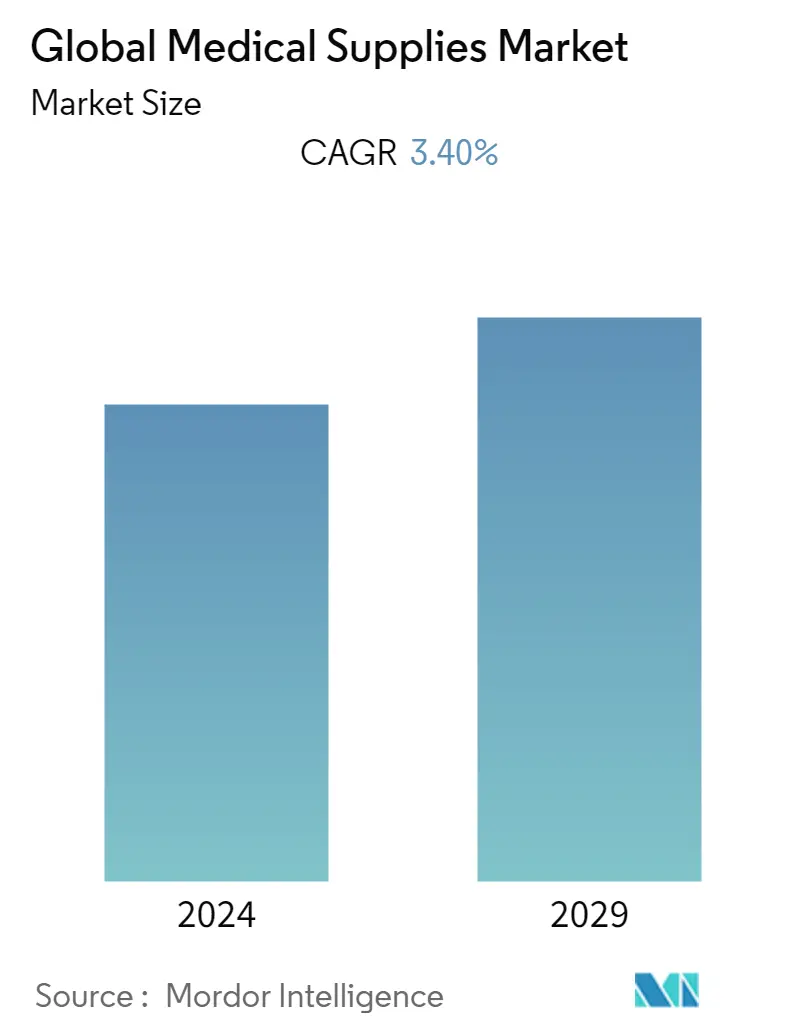
| Study Period | 2019 - 2029 |
| Base Year For Estimation | 2023 |
| CAGR | 3.40 % |
| Fastest Growing Market | Asia-Pacific |
| Largest Market | North America |
| Market Concentration | Low |
Major Players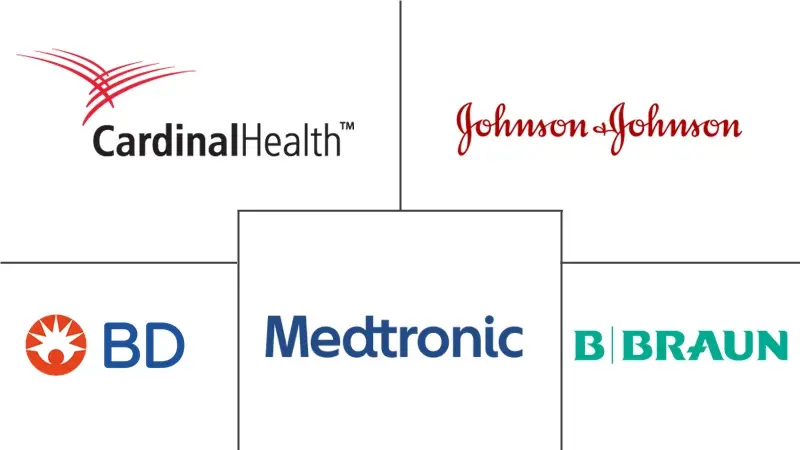
*Disclaimer: Major Players sorted in no particular order |
Medical Supplies Market Analysis
The Medical Supplies Market is expected to register a CAGR of 3.4% over the forecast period, 2022-2027. The COVID-19 pandemic had a mixed impact on the market. Currently, countries continue to face the huge threat of the pandemic. The supply chain disruption caused due to COVID-19 led to shortages of critical medical supplies worldwide. Therefore, many countries have taken definite measures to ease the shortages by importing supplies.
According to 'FDA,' July 2022, due to the COVID-19 pandemic, several restrictive measures have been implemented by the State federation's governments. Section 506J of the Federal Food, Drug, and Cosmetic Act (FD&C Act) reflects the categories of devices that Food and Drug Administration (FDA) has determined to be in shortage and maintained and updated as the COVID-19 public health emergency evolves. The major medical supplies in shortage are Dialysis-Related Products, Personal Protective Equipment, Testing Supplies and Equipment and Ventilation-Related Products. The shortage led to high demand for medical supplies, significantly contributing to the market.
According to 'Kaufman Hall National Hospital Flash Report,' published in January 2022, there is an increase of 20.6% in Hospital expenses per patient from 2019 to 2021 caused due to shortage of medical supplies. The most recent surges triggered by the delta and omicron variants have added even more pressure to hospitals. Adoption of suboptimal substitutes is a major issue in supply chain networks in hospitals. Following the pandemic, businesses may consider reducing dependence by implementing modern production techniques like additive manufacturing. Just in Time (JIT) policy was the standard in manufacturing companies prior to the pandemic. Supply chain agents maintain little finished goods or raw material inventory in the supply chain network under a just-in-time policy. But several of the products, including hand sanitizers and toilet paper, saw a sharp rise in demand. Therefore, there was a severe shortage of both raw materials and production capacity for the enterprises. As a result, the above response to COVID-19 implies that, while JIT may provide lower inventory costs, it is not appropriate during times of crisis. Hence, it will be necessary to change the sourcing strategy from global to local in the post-pandemic era. Supply chain managers take steps to change their global sourcing and work to find and promote local sources that offer comparable quality raw materials close to their production facilities. Hence there is high competition among the global as well as local players. Therefore, the post-pandemic period is expected to see an increase in the demand for medical supplies in the region.
Chronic diseases are the most prevalent health condition that involves significant expenditure. Chronic diseases include cancer, diabetes, hypertension, stroke, heart disease, respiratory diseases, arthritis, and obesity, which can lead to hospitalization, long-term disability, reduced quality of life, and even death. According to the World Health Organization (WHO), by 2022 approximately 422 million worldwide have diabetes in 2021, and 1.5 million deaths are directly attributed to diabetes each year. Both the number of cases and the prevalence of diabetes have been steadily increasing over the past few decades. According to the 'first comprehensive global analysis of trends in hypertension prevalence, detection, treatment and control' published in August 2021, the number of adults aged 30-79 years with hypertension has increased from 650 million to 1.28 billion in the last 30 years. The increasing prevalence of chronic and lifestyle diseases, and the high volume of cases of injuries places a great demand for medical supplies products. The high demand for market supplies drives the growth of the market.
Therefore, the factors mentioned above are attributed collectively to the studied market growth over the forecast period. However, a stringent regulatory framework is expected to hinder market growth over the forecast period.
Medical Supplies Market Trends
This section covers the major market trends shaping the Medical Supplies Market according to our research experts:
Catheter Segment is Expected to Witness High Growth Over the Forecast Period
A catheter is a thin, flexible tube that can put fluids into your body or take them out. There are five types of catheters: cardiovascular catheters, intravenous catheters, urological catheters, specialty catheters and neurovascular catheters. Catheters are found to hold the largest share which can be attributed to the rising incidence of cardiovascular disease and the increasing volume of catheter related surgeries, across the globe. According to the U.S. Census Bureau report, published in 2020, all four cardiovascular risk factors are expected to increase from 2025 to 2060, with the largest percentage increase in diabetes (39.3% increase to 55 million persons), followed by dyslipidemia (27.6% increase to 126 million persons), hypertension (25.1% increase to 162 million persons) and obesity (18.3% increase to 126 million persons). According to Centers for Disease Control and Prevention (CDC) in 2020, about 697,000 people in the United States died from heart disease out of which coronary heart disease is the most common type of heart disease, killing 382,820 people and about 805,000 people in the United States have a heart attack every year. With increase in prevalence of chronic diseases associated with urinary bladder, cardiovascular disease, and others are the major factors that drive the growth. In addition, the increase in demand for minimal invasive surgeries among patients owing to the increase disease prevalence and its treatment further fuels the segment growth.
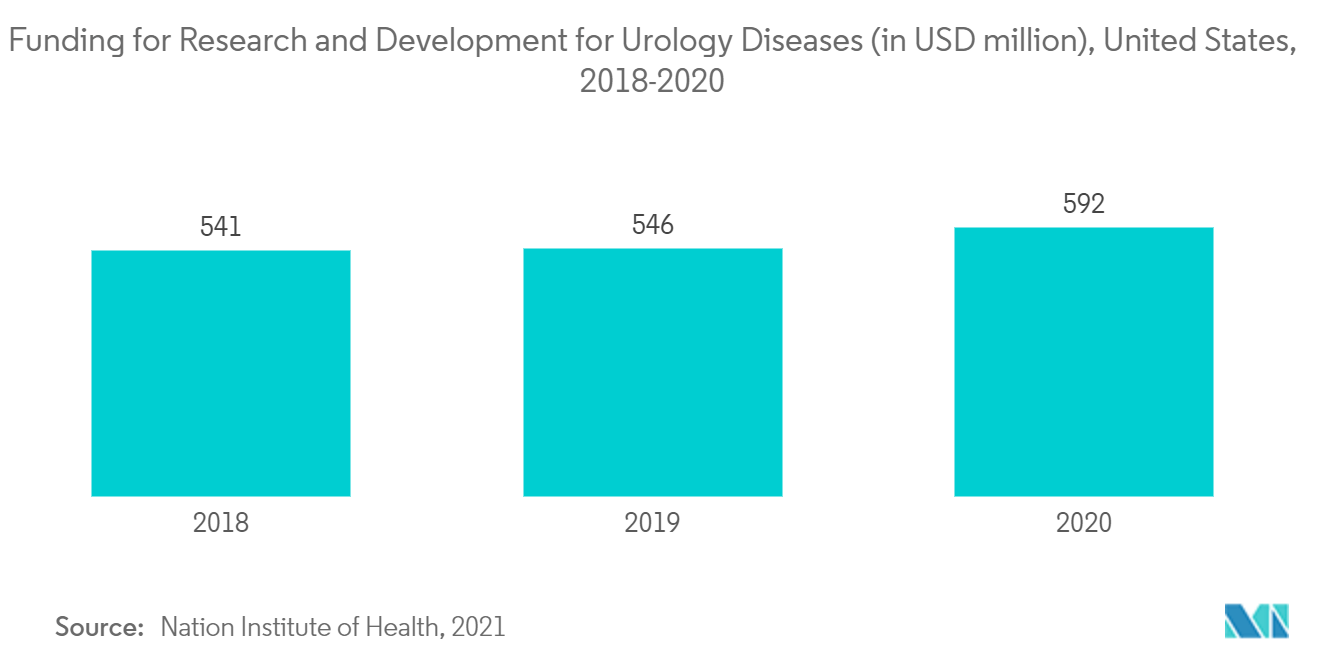
North America is Expected to Dominate the Medical Supplies Market
North America is expected to dominate the market owing to factors such as higher investment of yearly revenues in product innovation and constant improvement of existing technologies. The United States is the largest market in North America.
The US medical supply sector is an important part of the healthcare industry. The market has a very competitive landscape, with leading medical supply market players, such as Johnson & Johnson, Abbott, and Baxter International. According to the American Cancer Society 2021, about 1.9 million new cancer cases were diagnosed, including 268,490 cases of prostate cancer, 287,850 cases of invasive breast cancer, 236,740 cases of lung cancer, and 106,180 cases of colorectal cancer. These trends are likely to boost the growth of the market in the future.
Therefore, owing to the aforesaid factors the growth of the market studied is anticipated in the North America Region.
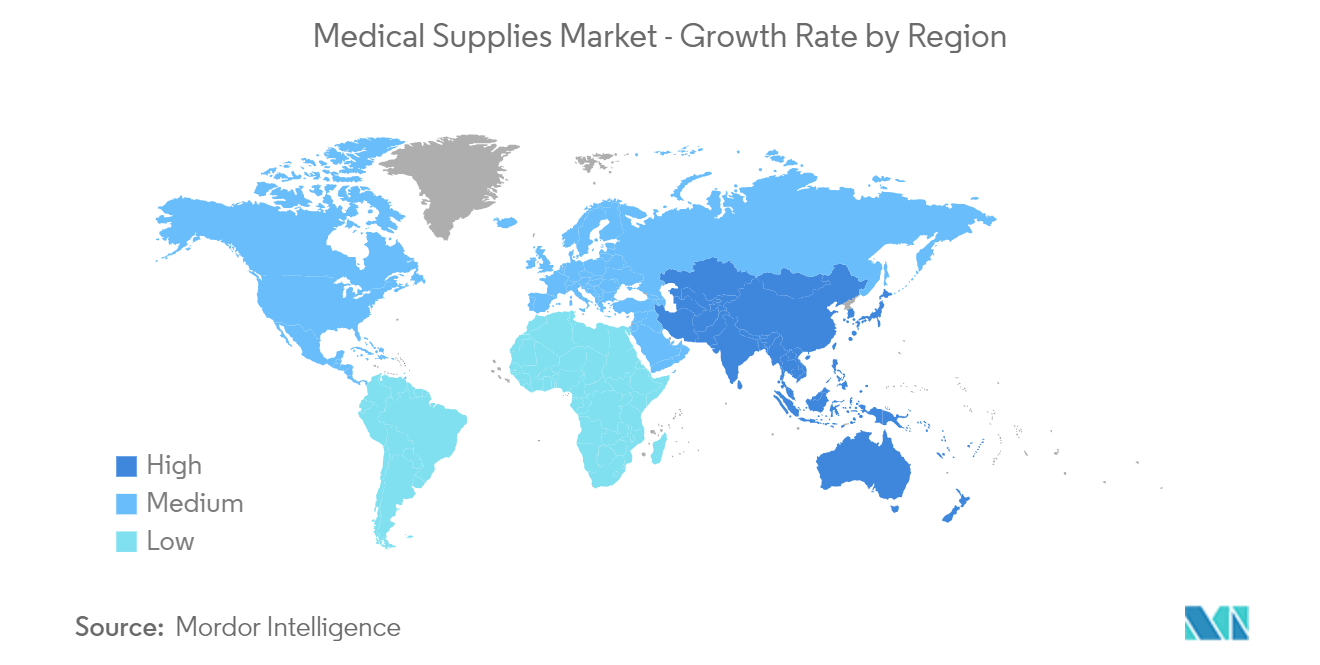
Medical Supplies Industry Overview
The Medical Supplies Market is fragmented in nature due to the presence of several companies operating globally as well as regionally. The competitive landscape includes an analysis of a few international as well as local companies which hold market shares and are well known. include Medtronic plc, Cardinal Health, Becton, Dickinson and Company, Johnson & Johnson Services, Inc., B. Braun Melsungen AG, Boston Scientific Corporation, Thermo Fisher Scientific, Inc., Baxter, 3M Company, and Smith & Nephew, among others.
Medical Supplies Market Leaders
-
Medtronic plc
-
Cardinal Health
-
Becton, Dickinson and Company
-
B. Braun Melsungen AG
-
Boston Scientific Corporation
*Disclaimer: Major Players sorted in no particular order
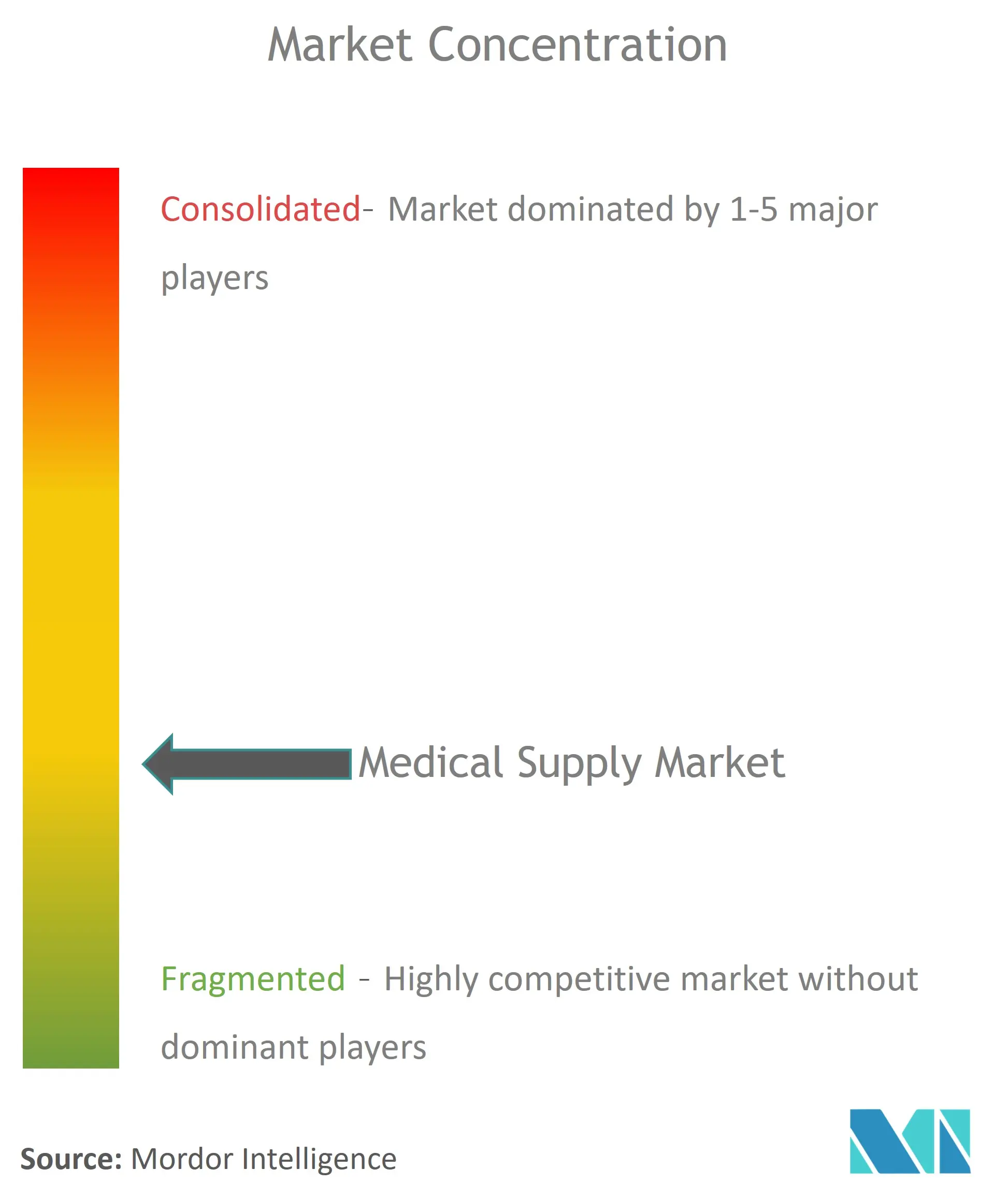
Medical Supplies Market News
- In February 2022, Medtronic plc launched its NuVent Eustachian tube dilation balloon. The tube is intended for the treatment of chronic and obstructive eustachian tube dysfunction.
- In April 2022, Boston Scientific Corporation received the FDA 510(k) clearance for the EMBOLD Fibered Detachable Coil. The coil will obstruct the blood flow in peripheral vasculature.
Medical Supplies Market Report - Table of Contents
1. INTRODUCTION
- 1.1 Study Assumptions and Market Definition
- 1.2 Scope of the Study
2. RESEARCH METHODOLOGY
3. EXECUTIVE SUMMARY
4. MARKET DYNAMICS
- 4.1 Market Overview
-
4.2 Market Drivers
- 4.2.1 Increasing Chronic Disease Prevalence
- 4.2.2 Rising Number of Medical Emergencies
- 4.2.3 Increase Number of Surgical Procedure and ICU Admission in Hospital and Surgical Centers
- 4.2.4 Government Initiative in Healthcare Funding
-
4.3 Market Restraints
- 4.3.1 Product Recalls
- 4.3.2 Country-level Medical Device Regulation
-
4.4 Porter's Five Force Analysis
- 4.4.1 Threat of New Entrants
- 4.4.2 Bargaining Power of Buyers/Consumers
- 4.4.3 Bargaining Power of Suppliers
- 4.4.4 Threat of Substitute Products
- 4.4.5 Intensity of Competitive Rivalry
5. MARKET SEGMENTATION (Market Size by Value - USD million)
-
5.1 By Product Type
- 5.1.1 Diagnostic Supplies
- 5.1.2 Infusion & Injectable Supplies
- 5.1.3 Intubation & Ventilation Supplies
- 5.1.4 Disinfectants
- 5.1.5 Personal Protective Equipment
- 5.1.6 Sterilization Consumables
- 5.1.7 Wound Care Consumables
- 5.1.8 Dialysis Consumables
- 5.1.9 Radiology Consumables
- 5.1.10 Catheters
- 5.1.11 Other Medical Supplies
-
5.2 By Application
- 5.2.1 Urology
- 5.2.2 Wound Care
- 5.2.3 Radiology
- 5.2.4 Respiratory
- 5.2.5 Infection Control
- 5.2.6 Cardiology
- 5.2.7 IVD
- 5.2.8 Other Applications
-
5.3 By End-User
- 5.3.1 Hospitals
- 5.3.2 Clinics/Physician Offices
- 5.3.3 Other End Users
-
5.4 Geography
- 5.4.1 North America
- 5.4.1.1 United States
- 5.4.1.2 Canada
- 5.4.1.3 Mexico
- 5.4.2 Europe
- 5.4.2.1 Germany
- 5.4.2.2 United Kingdom
- 5.4.2.3 France
- 5.4.2.4 Italy
- 5.4.2.5 Spain
- 5.4.2.6 Rest of Europe
- 5.4.3 Asia-Pacific
- 5.4.3.1 China
- 5.4.3.2 Japan
- 5.4.3.3 India
- 5.4.3.4 Australia
- 5.4.3.5 South Korea
- 5.4.3.6 Rest of Asia-Pacific
- 5.4.4 Middle East and Africa
- 5.4.4.1 GCC
- 5.4.4.2 South Africa
- 5.4.4.3 Rest of Middle East and Africa
- 5.4.5 South America
- 5.4.5.1 Brazil
- 5.4.5.2 Argentina
- 5.4.5.3 Rest of South America
6. COMPETITIVE LANDSCAPE
-
6.1 Company Profiles
- 6.1.1 Medtronic plc
- 6.1.2 Cardinal Health
- 6.1.3 Becton, Dickinson and Company
- 6.1.4 Johnson & Johnson Services, Inc.
- 6.1.5 B. Braun Melsungen AG
- 6.1.6 Boston Scientific Corporation
- 6.1.7 Thermo Fisher Scientific, Inc.
- 6.1.8 Baxter
- 6.1.9 3M Company
- 6.1.10 Smith & Nephew
- 6.1.11 Abbott
- 6.1.12 Convatec Inc.
- 6.1.13 Cook Medical
- 6.1.14 Stryker
- 6.1.15 Hamilton Medical
- *List Not Exhaustive
7. MARKET OPPORTUNITIES AND FUTURE TRENDS
** Subject To AvailablityMedical Supplies Industry Segmentation
As per the scope of the report, medical supply is known as medical or surgical items used in a healthcare setup that are consumable, expendable, disposable or non-durable and that are used for the treatment or diagnosis of a patient's specific illness, injury, or condition. The Medical Supplies Market is segmented by Product Type (Diagnostic Supplies, Infusion & Injectable Supplies, Intubation & Ventilation Supplies, Disinfectants, Personal Protective Equipment, Sterilization Consumables, Wound Care Consumables, Dialysis Consumables, Radiology Consumables, Catheters, Sleep Apnea Consumables, and Other Medical Supplies), Application (Urology, Wound Care, Radiology, Respiratory, Infection Control, Cardiology, IVD, and Other Applications), End-User (Hospitals, Clinics/Physician Offices and Other End-Users), and Geography (North America, Europe, Asia-Pacific, Middle East and Africa, and South America). The market report also covers the estimated market sizes and trends for 17 different countries across major regions, globally. The report offers the value (in USD million) for the above segments.
| By Product Type | Diagnostic Supplies | |
| Infusion & Injectable Supplies | ||
| Intubation & Ventilation Supplies | ||
| Disinfectants | ||
| Personal Protective Equipment | ||
| Sterilization Consumables | ||
| Wound Care Consumables | ||
| Dialysis Consumables | ||
| Radiology Consumables | ||
| Catheters | ||
| Other Medical Supplies | ||
| By Application | Urology | |
| Wound Care | ||
| Radiology | ||
| Respiratory | ||
| Infection Control | ||
| Cardiology | ||
| IVD | ||
| Other Applications | ||
| By End-User | Hospitals | |
| Clinics/Physician Offices | ||
| Other End Users | ||
| Geography | North America | United States |
| Canada | ||
| Mexico | ||
| Geography | Europe | Germany |
| United Kingdom | ||
| France | ||
| Italy | ||
| Spain | ||
| Rest of Europe | ||
| Geography | Asia-Pacific | China |
| Japan | ||
| India | ||
| Australia | ||
| South Korea | ||
| Rest of Asia-Pacific | ||
| Geography | Middle East and Africa | GCC |
| South Africa | ||
| Rest of Middle East and Africa | ||
| Geography | South America | Brazil |
| Argentina | ||
| Rest of South America |
Medical Supplies Market Research FAQs
What is the current Global Medical Supplies Market size?
The Global Medical Supplies Market is projected to register a CAGR of 3.40% during the forecast period (2024-2029)
Who are the key players in Global Medical Supplies Market?
Medtronic plc, Cardinal Health, Becton, Dickinson and Company, B. Braun Melsungen AG and Boston Scientific Corporation are the major companies operating in the Global Medical Supplies Market.
Which is the fastest growing region in Global Medical Supplies Market?
Asia-Pacific is estimated to grow at the highest CAGR over the forecast period (2024-2029).
Which region has the biggest share in Global Medical Supplies Market?
In 2024, the North America accounts for the largest market share in Global Medical Supplies Market.
What years does this Global Medical Supplies Market cover?
The report covers the Global Medical Supplies Market historical market size for years: 2019, 2020, 2021, 2022 and 2023. The report also forecasts the Global Medical Supplies Market size for years: 2024, 2025, 2026, 2027, 2028 and 2029.
Medical Supply Industry Report
Statistics for the 2024 Medical Supply market share, size and revenue growth rate, created by Mordor Intelligence™ Industry Reports. Medical Supply analysis includes a market forecast outlook to 2029 and historical overview. Get a sample of this industry analysis as a free report PDF download.



